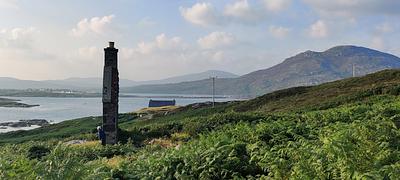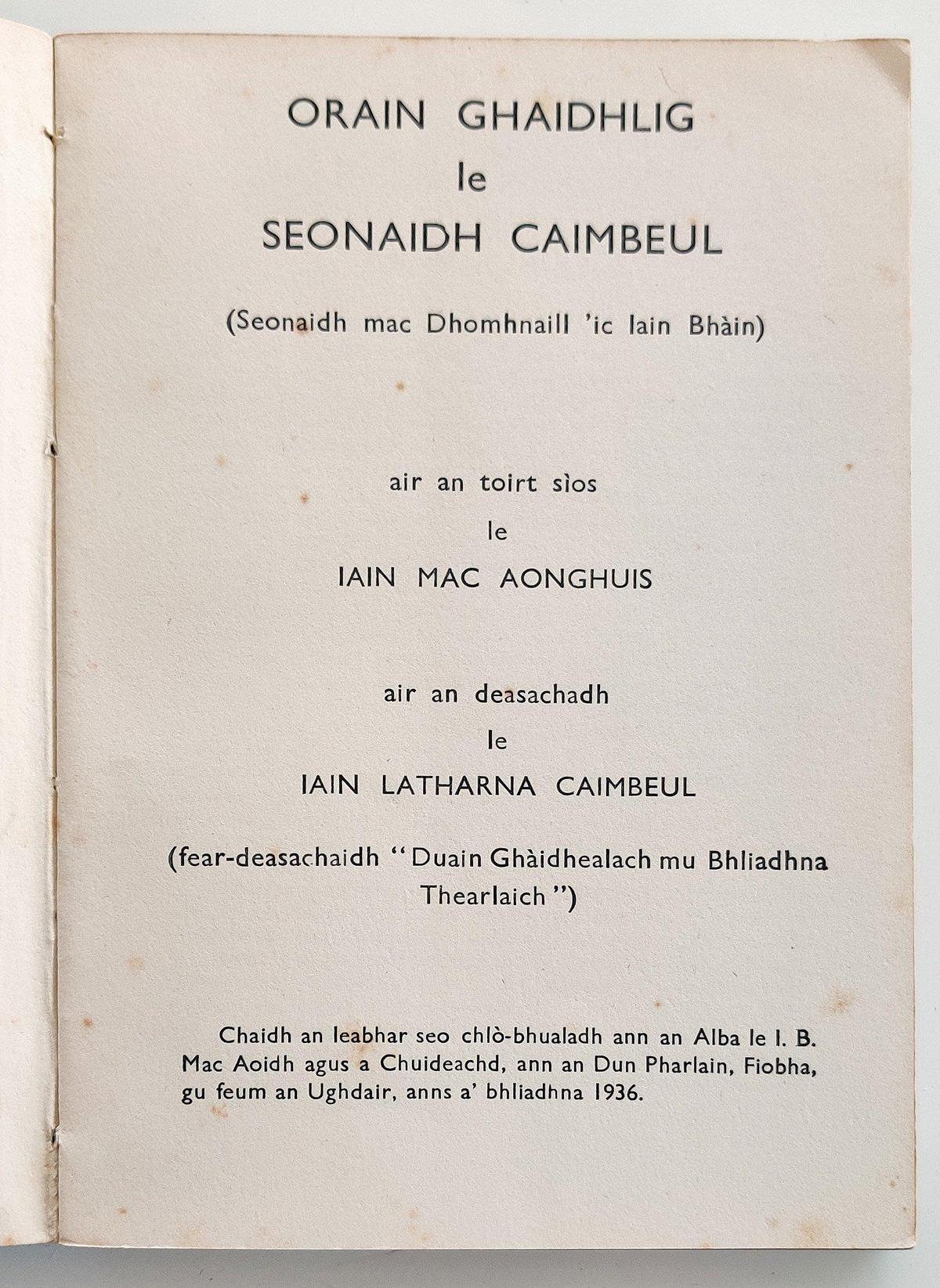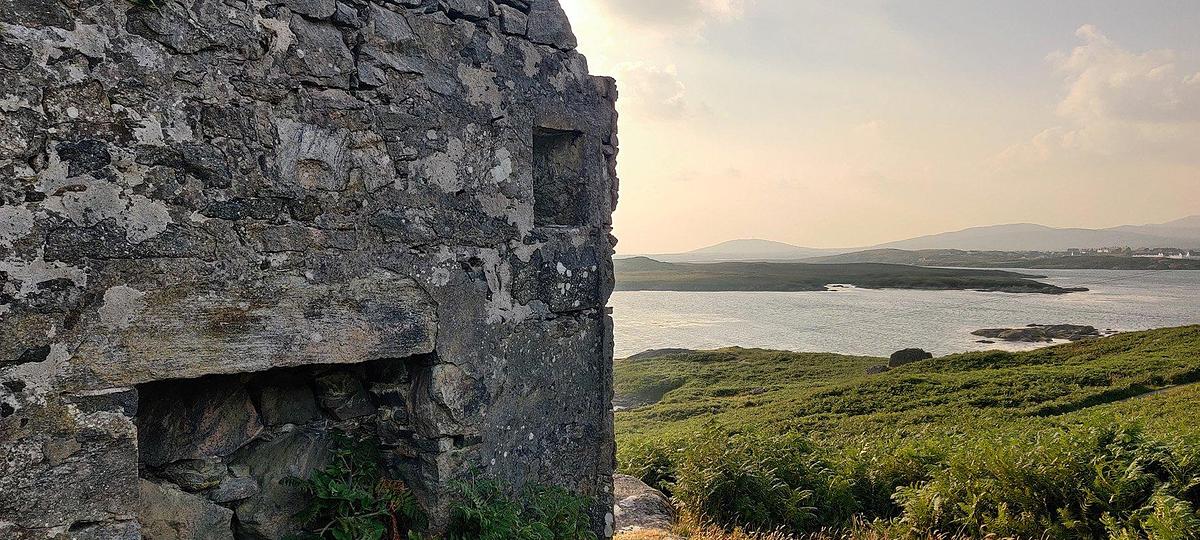
Seonaidh Caimbeul – a lost recording of a Uist bard
Until recently, the oldest recordings on the Tobar an Dualchais dated back to 1937. When giving public presentations, we would present a clip of Anna MacDougall of Glen, Barra, singing a snippet of O Hùg O, Chailleach Chrùbach from this year, which was the oldest recording on the website at that time (TAD ID 40457).
There is a crackling on the recording that gives away its age and yet the informality of the moment captured – with Anna and some other ladies in the background chuckling as they forget and remind each other of the words to the song – seems to transport the listener back in time.
This recording was made by the eminent Gaelic Scholar John Lorne (JL) Campbell who lived in Barra from 1933-1937, just before he and his wife and professional collaborator, Margaret Fay Shaw, bought the Island of Canna and relocated there in 1938. Of the early recordings made by Campbell, there are 11 available on Tobar an Dualchais from 1937.
This number jumps to 175 the following year, as Campbell upgraded from an Edison wax-cylinder recorder to a Presto disk recorder.
Knowing this timeline, it was a surprise when trawling through our database for unpublished material for a community event in South Uist to find an even older recording, from 1935.
It is of Seonaidh Campbell, Seonaidh mac Dhòmhnaill ‘ic Iain Bhàin (1859-1945), of South Lochboisdale, telling an anecdote about two unemployed friends conversing and having a bowl of soup together before one man gets the better of the other.
.jpg)
The anecdote is told at a lovely pace, in beautiful South Uist Gaelic, and the recording itself is remarkably clear (TAD ID: 41039).
After meeting Seonaidh’s next of kin at a recent Tobar an Dualchais event held at Cnoc Soillier in South Uist, permission was granted to make the recording available online.
We now have a new ‘oldest recording’ on the Tobar an Dualchais website!
The recording is, however, an anomaly. John Lorne Campbell did not purchase his Ediphone until 1936, a year after this recording was made.
So, a bit of digging was required to find out more, not only about how the recording had come to be made, but also about the man it featured.
Significantly, this is the only recording we have of Seonaidh Campbell on Tobar an Dualchas, although his influence can be heard throughout the website.
Seonaidh Campbell was born in 1859 and lived in South Lochboisdale. He attended school from the age of nine or ten but did not learn to read or write in Gaelic or English until he was much older.
JL Campbell described Seonaidh in 1939 as a monoglot Gaelic-speaker, but others say that he could speak three languages, Gaelic, English and Doric, the latter having been picked up during his years at sea, having fished alongside East coast fishermen.
He became a highly regarded bàrd baile (village poet) who wrote poems and songs about people, events and topics of the day.
Others in his family were particularly gifted as bards and include his nephew, Roderick (Ròidseag) Campbell, the composer of ceilidh classics which include A Phèigi a Ghràidh, Fàgail Ghlaschu and Òran na h-Airship, which are still sung to this day.
Seonaidh’s close friend Iain Pheadair (John MacInnes) is recorded talking about his life and also provides an anecdote about a poetic exchange between Seonaidh and Father John MacMillan of Barra (TAD ID: 128986).
Iain had just come from visiting Fr. MacMillan, the latter asking him to give Seonaidh some verse he had composed for Seonaidh.
Iain described how, after hearing the message, Seonaidh laid down on his beinge (bench) and after about five minutes had created a beautiful, well crafted, poetic response for his friend in Barra, which Iain recites in the recording.
Iain Pheadair collaborated with JL Campbell on a book of songs by Seonaidh entitled ‘Òrain Ghàidhlig le Seonaidh Caimbeul’, which was published in 1936.

For this, Iain diligently transcribed over a hundred songs by Seonaidh of which forty-five were printed. JL Campbell also made audio recordings of many of Seonaidh’s songs, including Iain’s rendition of Òran nan Stocainnean (TAD ID: 40803), a song still popular with Gaelic singers today.
A fantastic recording of Norman MacLean singing it for Hamish Henderson in 1952 is also available (TAD ID 53752).
Seonaidh’s songs certainly travelled. He was well known amongst the Uist folk who emigrated on the Marloch in 1923, as a recording from Alberta, Canada made by Margaret MacKay in 1979 of a man singing Òrain a Pheinnsein testifies.
It is another classic by Seonaidh, made to mark the introduction of the state pension in 1908. Although we don’t know the name of this contributor, he knew Seonaidh and described him as a “fine old man”, in his wonderful Canadian ‘twang’ (TAD 103405).
To my shame as a proud Uibhisteach, I wasn’t aware of Seonaidh Campbell before this recording landed in my inbox, although I was familiar with some of his songs.
After a quick phone call home my parents gave me a full account of his lineage. Sabhal Mòr Ostaig librarian Greg MacThòmais kindly looked out a copy of ‘Orain Ghàidhlig le Seonaidh Caimbeul’ for me and Fiona MacKenzie (former archivist at Canna House) sent a few photographs of Seonaidh taken by Margaret Fay Shaw.
My knowledge of Seonaidh was beginning to expand. I particularly enjoyed learning about him from Paul McCallum of South Lochboisdale.
Paul explained that Seonaidh lived in a house built for him by his brother, Iain, a very well-regarded stonemason and also a poet.
The style of house was known as ‘leth taigh’ (half house) which meant that one gable end and chimney were made of stone and the rest framed in timber and clad with corrugated metal.
That wall stands proudly looking over Loch Boisdale to this day.
As the recording from Alberta suggests, Seonaidh was very well-liked and respected. Margaret Fay Shaw noted that he was ‘noble in character and sharp in wit’ in her book, Folksongs and Folklore of South Uist. Paul told me that his mother described Seonaidh as having “cruth aodann aingeal”, (the face of an angel).
Another popular South Uist Bard, Donald MacDonald, Dòmhnaill Aillean Dhòmhnaill na Bainnich, did not rate himself as half the bard that Seonaidh was because he had not written a hymn. Seonaidh wrote many and he was a man of deep faith.
Paul told me there was a small recess built into the stone gable where Seonaidh kept his bible close to hand.
As Paul pointed out, “Chan e tric a bhiodh am Bìoball ann an taigh Caitligeach ach bha Seonaidh ga leughadh tric.” (It’s not often that a Bible is found in a Catholic house, but Seonaidh read his often.)
Thanks to some directions from Seonaidh’s relatives, Dòmhnall Ruairidh and Mary Ann Campbell, I took a walk to see what remains of his house on a beautiful evening in July. South Lochboisdale and North Glendale were in their full glory.
Along with my youngest son, Mìcheal, I walked along the path and up a steep embankment to where the lone gable stands.

What a view! So connected was Seonaidh and his wife Peigi to this place that, when they eventually left to stay with relatives in Loch Eynort due to ill health, they pulled a thick blanket over their heads as they sailed out of the sea loch; they could not bring themselves to see the place they loved fade into the distance.
But back to the recording. The notes with the original recording explain a bit more about this 88-year-old anomaly:
In the last month of autumn 1935, John Lorne Campbell, John MacInnes, and Seonaidh Campbell, went to Glasgow to make a recording of Uist Gaelic for the BBC, who wished to record for posterity all the languages and dialects found in Scotland. This was the first Gaelic record of its kind ever made in Scotland, and it was a great honour for Seonaidh that it was he who recorded it.
I’m pleased that JL Campbell was given a copy of the recording from the BBC and that it has ended up in the TAD database.
I am grateful to Domhnall Ruairidh and Dòmhnall Anthony Campbell for giving their permission for this recording to be available on our website.
As well as being our oldest recording, it is a wonderful tribute to a man who was, by all accounts, as fine a gentleman, bard and tradition bearer as can be found anywhere on the Tobar an Dualchas website.